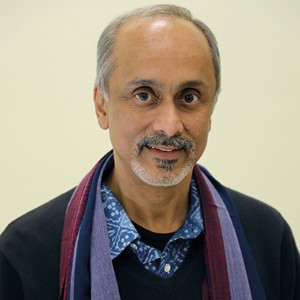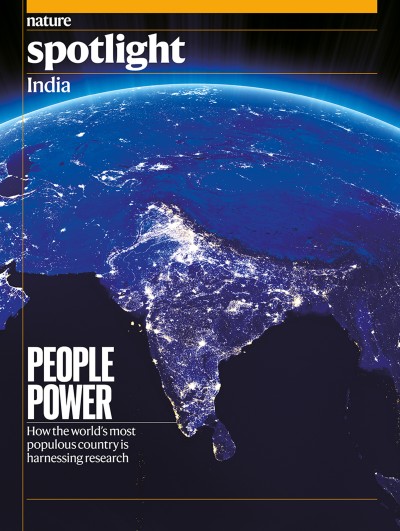Old Delhi’s Red Fort, a nearly 400-year-old structure where India’s flag is hoisted every Independence Day, is separated from the Yamuna River by a 55-kilometre ring road that circles the capital. I drive past it on this road, built on an old floodplain, on my way to work at Ashoka University in the neighbouring state of Haryana, a further 30 kilometres or so upstream. The river is hidden from view in places but it can be seen farther along, narrow and darkened by pollution for most of the year.
In July 2023, flood water from heavy monsoon rains entered the Yamuna from Haryana, flooding parts of Delhi. TV images of the river lapping at the walls of the Red Fort recalled nineteenth-century paintings of the old course of the river.
The Yamuna forms from the melting glaciers of the lower Himalayas, running for more than 1,370 kilometres until it merges with the Ganga in the city of Prayagraj in Uttar Pradesh. Delhi lies along its banks for just 20 kilometres, less than 2% of the river’s total length. But in that short stretch, the city belches out around 80% of the pollution found in the Yamuna. In some seasons, a foamy mixture of sewage and industrial waste coats the river surface in parts of Delhi. Newspapers carry pictures of Hindu devotees offering morning prayers while standing knee-deep in this toxic foam.
Much of Haryana’s ground water is used to cultivate rice. Farmers pump it up using electricity that the state government heavily subsidizes to encourage agriculture. Without economic incentives to use this electricity sustainably, groundwater levels declined precipitously from the 1990s into the early 2000s. To combat this, legislation was introduced in 2009 to restrict the sowing of rice to mid-June onwards, timed to begin after the start of the monsoon season. Previously, rice planting had started as early as May.
This means that the rice-harvesting season ends even closer to the wheat planting season, which begins in November. Farmers need to get rid of their rice-crop residue as soon after harvesting as possible to clear space for the wheat.
Burning the crop residue is the cheapest solution. But in the early winter months, smoke and dust released from a combination of residue burning and other sources is concentrated by frequent changes in temperature and stagnant winds, and shrouds northern India. Schools are closed, construction work is halted and flights are grounded because of the poor visibility. Hospitals fill with people complaining of breathing difficulties. Each resident of Delhi is thought to lose nearly 12 years of their life to air pollution.
As the world’s climate changes, extreme events such as the rains that led to the Delhi floods in July will become more common. The southern Indian state of Kerala witnessed a devastating flood in 2018, the worst in almost a century of recorded history. More than one million people were evacuated to higher ground. A study that year showed that about 60% of the coast of Kerala was eroding, and areas where good fishing could be found were shifting, affecting the lives of one million fishers and their families.
Two large Indian cities, Chennai, on the Bay of Bengal, and Kolkata, on the banks of the Hooghly River, are expected to be at significant risk from sea-level rise in the next few decades. Along with the resulting intrusion of salt water into groundwater systems, this will increase climate-change-induced migration. The Sundarbans, an ecologically sensitive wetland system on the Bay of Bengal that contains the largest mangrove forest in the world, has already seen substantial climate-change-driven migration into the nearby city of Kolkata.
The Namami Gange Programme is one of many started since the mid-1980s to clean up India’s iconic holy river, the Ganga. Around US$3 billion for this has been set aside or spent since 2014, largely on new sewage-treatment plants.
But pollution levels remain stubbornly high, the result of lax enforcement of control measures and unregulated river-front development. More data are needed, and more transparency on the causes, so citizens can hold civic bodies and elected representatives responsible.
Science can help too. The Ministry of Earth Sciences is funding several initiatives aimed at improving India’s ability to model the monsoon. This will help provide actionable advance warnings of extreme rain events. More research on the geomorphology of coastal India, on near-shore ocean current patterns and on the impact of sea walls could aid the design of interventions to slow coastal erosion.
Fresh water is a finite and vulnerable resource that should be managed in a participatory fashion. Citizen groups in the south-Indian city of Bengaluru are helping to renew urban water bodies, reconfiguring them as centres around which communities can coalesce. In arid areas, such as the deserts of Rajasthan and Gujarat, old methods of rainwater harvesting are being revived, helped by traditional community knowledge.
Guaranteeing a minimum amount of fresh water for each individual, free of charge, will ensure broader societal equity. Beyond that limit, water usage should be priced, creating an economic incentive for its sustainable use. Such a policy was introduced nearly a decade ago by the Delhi government, but continued groundwater extraction using illegal borewells has partly neutralized this positive step.
Ensuring the sustainable use of water intersects climate change, agriculture, politics, pollution, migration and much more. Well-intentioned policy measures, such as subsidizing electricity for agriculture, can have unexpected consequences for water and its sustainable use.
Placing water at the centre of our thinking about sustainability can help avoid such pitfalls. We need more conversations about water.



 India’s year in science
India’s year in science
 Where science meets Indian economics: in five charts
Where science meets Indian economics: in five charts
 Renewable energy for the subcontinent
Renewable energy for the subcontinent
 The climate disaster strikes: what the data say
The climate disaster strikes: what the data say
 I predict solar storms
I predict solar storms
 The fight against antimicrobial resistance
The fight against antimicrobial resistance
 How high-impact papers from Indian researchers are shaping science
How high-impact papers from Indian researchers are shaping science
 India struggles to turn science into societal benefits
India struggles to turn science into societal benefits
 Big ideas: India’s drive to stem the brain drain
Big ideas: India’s drive to stem the brain drain
 I study depression in the lab and advocate for mental health in academia
I study depression in the lab and advocate for mental health in academia




